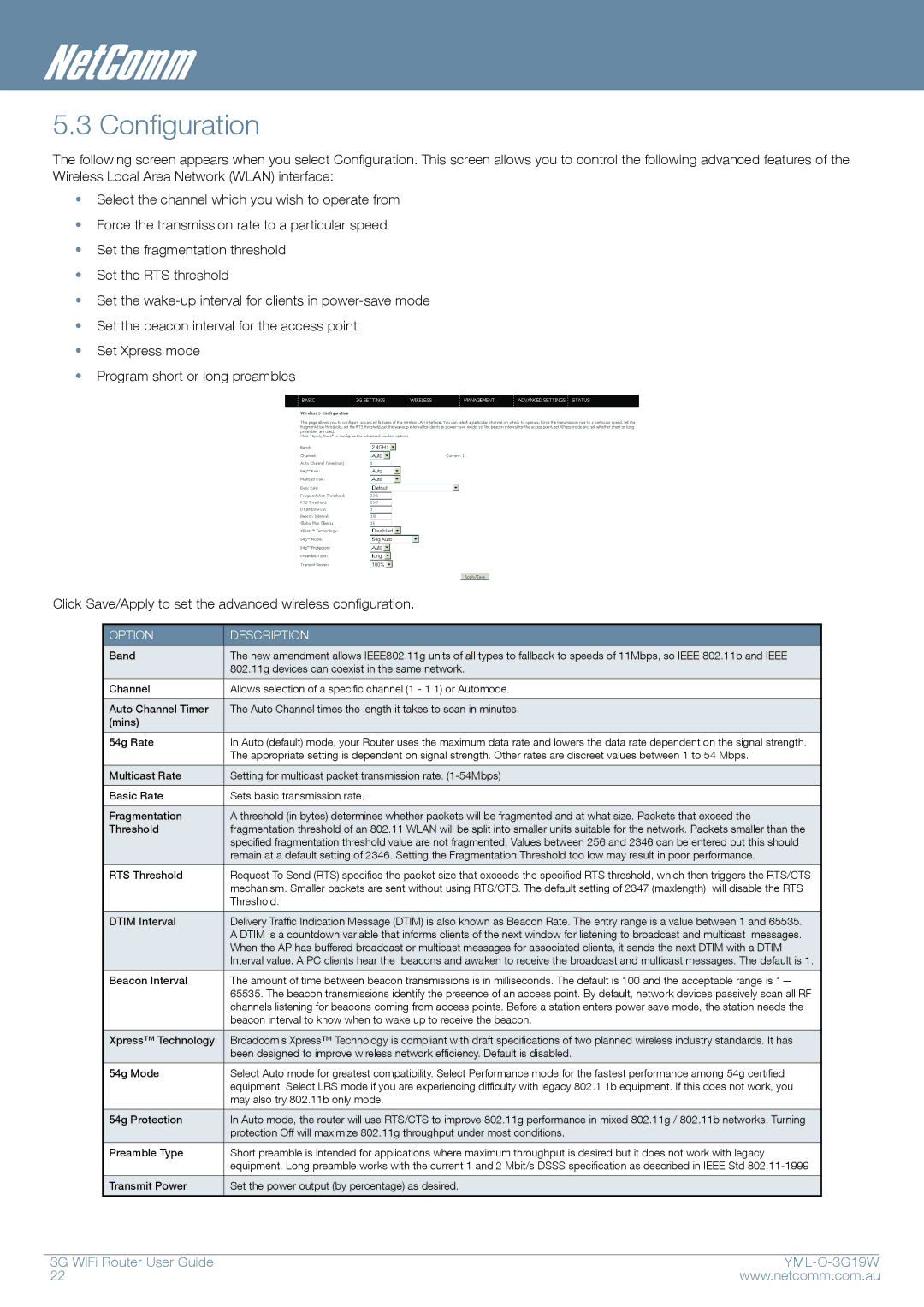
5.3 Configuration
The following screen appears when you select Configuration. This screen allows you to control the following advanced features of the Wireless Local Area Network (WLAN) interface:
•Select the channel which you wish to operate from
•Force the transmission rate to a particular speed
•Set the fragmentation threshold
•Set the RTS threshold
•Set the
•Set the beacon interval for the access point
•Set Xpress mode
•Program short or long preambles
Click Save/Apply to set the advanced wireless configuration.
OPTION | DESCRIPTION |
|
|
Band | The new amendment allows IEEE802.11g units of all types to fallback to speeds of 11Mbps, so IEEE 802.11b and IEEE |
| 802.11g devices can coexist in the same network. |
|
|
Channel | Allows selection of a specific channel (1 - 1 1) or Automode. |
|
|
Auto Channel Timer | The Auto Channel times the length it takes to scan in minutes. |
(mins) |
|
|
|
54g Rate | In Auto (default) mode, your Router uses the maximum data rate and lowers the data rate dependent on the signal strength. |
| The appropriate setting is dependent on signal strength. Other rates are discreet values between 1 to 54 Mbps. |
|
|
Multicast Rate | Setting for multicast packet transmission rate. |
|
|
Basic Rate | Sets basic transmission rate. |
|
|
Fragmentation | A threshold (in bytes) determines whether packets will be fragmented and at what size. Packets that exceed the |
Threshold | fragmentation threshold of an 802.11 WLAN will be split into smaller units suitable for the network. Packets smaller than the |
| specified fragmentation threshold value are not fragmented. Values between 256 and 2346 can be entered but this should |
| remain at a default setting of 2346. Setting the Fragmentation Threshold too low may result in poor performance. |
|
|
RTS Threshold | Request To Send (RTS) specifies the packet size that exceeds the specified RTS threshold, which then triggers the RTS/CTS |
| mechanism. Smaller packets are sent without using RTS/CTS. The default setting of 2347 (maxlength) will disable the RTS |
| Threshold. |
|
|
DTIM Interval | Delivery Traffic Indication Message (DTIM) is also known as Beacon Rate. The entry range is a value between 1 and 65535. |
| A DTIM is a countdown variable that informs clients of the next window for listening to broadcast and multicast messages. |
| When the AP has buffered broadcast or multicast messages for associated clients, it sends the next DTIM with a DTIM |
| Interval value. A PC clients hear the beacons and awaken to receive the broadcast and multicast messages. The default is 1. |
|
|
Beacon Interval | The amount of time between beacon transmissions is in milliseconds. The default is 100 and the acceptable range is 1— |
| 65535. The beacon transmissions identify the presence of an access point. By default, network devices passively scan all RF |
| channels listening for beacons coming from access points. Before a station enters power save mode, the station needs the |
| beacon interval to know when to wake up to receive the beacon. |
|
|
Xpress™ Technology | Broadcom’s Xpress™ Technology is compliant with draft specifications of two planned wireless industry standards. It has |
| been designed to improve wireless network efficiency. Default is disabled. |
|
|
54g Mode | Select Auto mode for greatest compatibility. Select Performance mode for the fastest performance among 54g certified |
| equipment. Select LRS mode if you are experiencing difficulty with legacy 802.1 1b equipment. If this does not work, you |
| may also try 802.11b only mode. |
|
|
54g Protection | In Auto mode, the router will use RTS/CTS to improve 802.11g performance in mixed 802.11g / 802.11b networks. Turning |
| protection Off will maximize 802.11g throughput under most conditions. |
|
|
Preamble Type | Short preamble is intended for applications where maximum throughput is desired but it does not work with legacy |
| equipment. Long preamble works with the current 1 and 2 Mbit/s DSSS specification as described in IEEE Std |
|
|
Transmit Power | Set the power output (by percentage) as desired. |
|
|
3G WiFi Router User Guide |
| |
22 | www.netcomm.com.au | |
